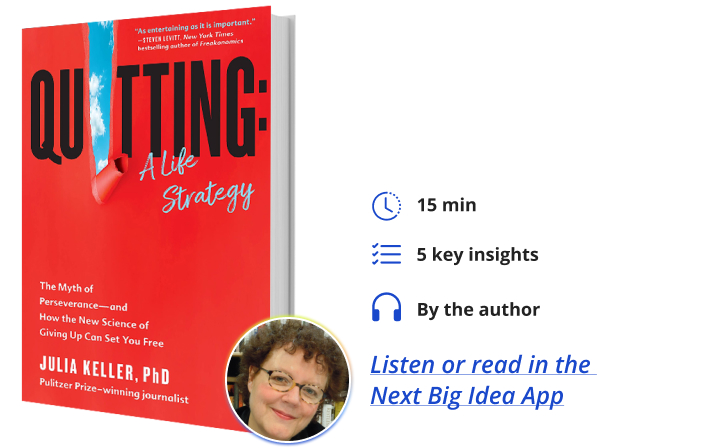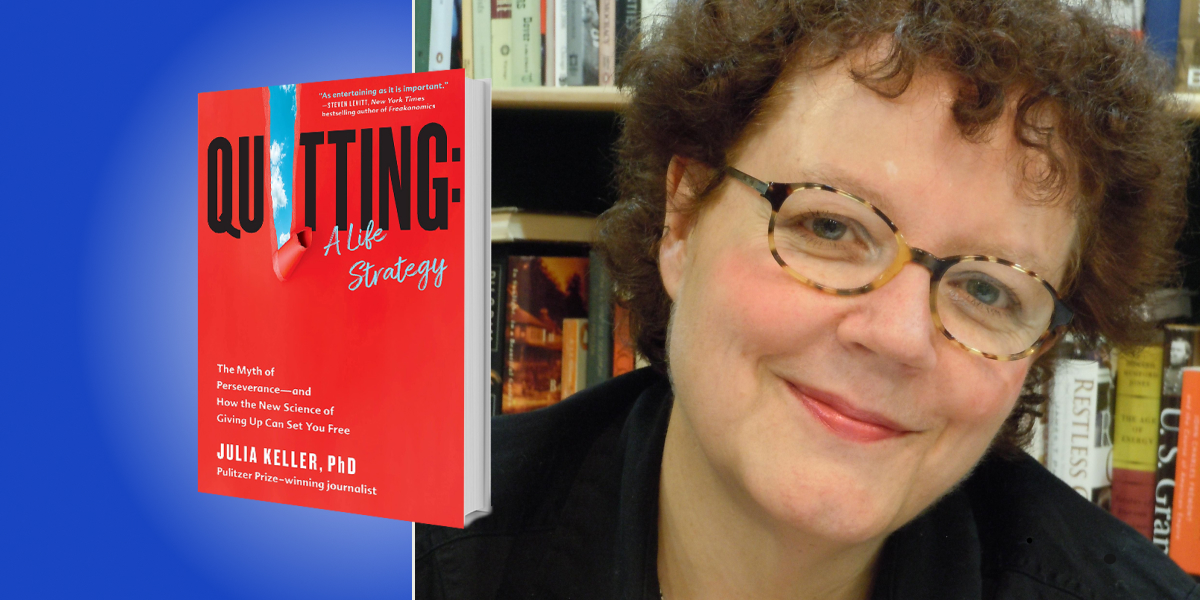Julia Keller has a Ph.D. in English Literature from the Ohio State University, and has taught at Princeton University, the University of Chicago, and the University of Notre Dame. Previously, she was the chief book critic and a staff writer at The Chicago Tribune and is a Pulitzer Prize winner for feature writing. She is also a guest essayist on The NewsHour with Jim Lehrer on PBS and has been a contributor on CNN and NBC Nightly News.
Below, Julia shares 5 key insights from her new book, Quitting: A Life Strategy: The Myth of Perseverance—and How the New Science of Giving Up Can Set You Free. Listen to the audio version—read by Julia herself—in the Next Big Idea App.

1. Grit is a con, and it’s sold to us like cars, cornflakes, and smartphones.
At 19 years old, I left home to take a post as a graduate teaching assistant at West Virginia University. After graduating from college early, it seemed like a fine idea to pursue an advanced degree in English Literature. Alas, it was a disaster: I’d never lived on my own before and I was, to my embarrassment, appallingly immature.
One month in, homesick and miserable, I found myself sitting cross-legged on the grimy linoleum floor of my tiny apartment, sobbing hysterically. I wanted to go home, but I was afraid of being called a quitter. That’s when I began to ask myself: where did we get the idea in the first place that grit is so all-fired great? Sometimes quitting is absolutely the right thing to do, but we don’t do it, because we believe we’ll be called cowards or weaklings.
Our blind worship of grit didn’t just pop up from out of nowhere; grit’s positive image got a major polish in the middle of 19th century London. An enterprising Scot named Samuel Smiles, and yes, that was his real name, published a book called Self-Help; with Illustrations of Character and Conduct. It was a huge hit because it told people what they wanted to hear: that the difference between the rich and the poor came down to effort. It claimed that success had nothing to do with whether you were born white, or born to wealthy parents; rich people worked hard, and the poor quit. The Industrial Revolution was in full swing at this time, and a small number of individuals were making vast fortunes, while the majority lived in terrible poverty, and terrible despair. How to justify this disparity? Why, chalk it up to the grit of those gazillionaires at the top, they worked harder than other people.
“Sometimes quitting is absolutely the right thing to do, but we don’t do it, because we believe we’ll be called cowards or weaklings.”
Smiles is often regarded as the father of the self-help movement. Today, books and podcasts that preach the Gospel of Grit are everywhere: t-shirts, bumper stickers, screensavers, mouse pads, and coffee mugs. Slogans of self-help from “Winners never quit and quitters never win!” to “Keep on keepin’ on!” are everywhere and we’ve accepted that advice for a long time without ever seriously questioning it.
2. How is Simone Biles like a honeybee?
That sounds like a silly question, but it’s not. It’s a way of pointing out how other animals with whom we share this planet deal with quitting—here’s a hint, they do it better.
Biles, of course, is one of the greatest athletes in history, that’s why the world was so stunned when she withdrew from the finals of the Tokyo Olympics. As she explained later, she felt uncharacteristically tentative and anxious about undertaking the perilous mid-air maneuvers that elite gymnasts must perform. The penalty for a mistake up there can be severe: catastrophic injury or worse. “It’s basically life or death,” Biles said. She took herself out of the competition in the final round resulting in her immediately being pelted with accusations on social media of having let her team and country down; she was called a quitter. In the animal world, however, quitting is a highly effective survival strategy, switching out an unprofitable path for one that might be more profitable is how animals stay alive, long enough to reproduce at least.
“She weighs the danger against what’s at stake, measuring the imminent peril against the chances of success and the potential reward.”
Take the honeybee: when a predator approaches the colony, a honeybee will defend it with her life. It’s always a “her,” because only the females sting, and for her, stinging means certain death; the sting eviscerates her. Sometimes, however, honeybees decide not to sting, according to renowned entomologist Justin O. Schmidt. His experiments have proven that honeybees make a very quick, crucial risk-benefit calculation: they decide if a colony is fertile and if a predator poses a definite threat. If both of those criteria check out, she’s happy to sting, happy to perish for the greater good. However, if the colony isn’t likely to produce any more honeybees, and if the threat is diminished, the honeybee stands down. She weighs the danger against what’s at stake, measuring the imminent peril against the chances of success and the potential reward, and if the ratio doesn’t make sense, she quits. Like a honeybee, Biles decided that the competition at that moment wasn’t worth the risk of death; quitting was her best strategy.
3. Quitting is like aerobics for your brain.
If you walk into Dr. Misha Ahrens’s lab at the Howard Hughes Medical Institute, you’ll see row upon row upon row of aquariums, and swimming inside them are the tiny zebrafish he uses in his experiments. Employing techniques such as genetic engineering and three-dimensional microscopy, Ahrens and his team have learned how a particular kind of brain cell enables a zebrafish to quit, stop swimming, and then start again—or not.
Other neuroscientists, too, are now able to pinpoint the place in the brain where quitting happens, where one path is relinquished and another begins. The new science of quitting has great potential to improve human lives; the discoveries could help in the search for effective treatments for drug and alcohol addiction, or bring relief from afflictions such as obsessive-compulsive disorder. Even for those fortunate enough to not suffer from serious maladies, quitting can still be a good thing. It keeps the brain in motion, and an active brain is a happy brain. Cognitive flexibility—a fancy name for quitting and reconfiguring your path multiple times—is one of the best things you can do to keep your brain working at peak efficiency.
4. Things. Just. Happen.
Sharon Harvey ran the cardiology unit at the world-famous Cleveland Clinic for many years. One day, she was visiting her local animal shelter and saw a dog named Hugh. Hugh had been found in a lonely, deserted alley, hungry, shivering, and near death. He and Sharon bonded instantly and Sharon decided to adopt him. Hugh inspired Sharon to quit her job and become the director of the shelter. “I credit him,” she said, “for giving me the courage to make such a big honking career shift because I’m not a risk taker and I don’t love change.” But Hugh, she said, reminded her of how much she loved animals. What if Hugh hadn’t been rescued in time? What if Sharon hadn’t visited the shelter that day and met him?
“Whirled about by chaos and uncertainty, we hang on as best we can, but we can’t control everything.”
Life is ridiculously random and infuriatingly illogical. Life isn’t fair. Whirled about by chaos and uncertainty, we hang on as best we can, but we can’t control everything. The self-help movement insists that we can and that what happens to us is entirely due to our own efforts—if we grit our teeth and don’t give up, we’ll succeed. There’s a better solution to dealing with this uncertainty: quit, reconnoiter, and move forward again when you know where you want to go.
5. All quitting is not created equal; there is a better way to do it.
When Tiger Woods returned to the golf course after a near-fatal car accident and many months of grueling rehabilitation, he chose a high-profile venue: The Masters Tournament. There he revealed a new dimension to his game: he had become a quitter. He didn’t throw down his club and storm off the course, but he did leave behind the relentless perfectionism that had always defined his play. He didn’t win that tournament, he came in forty-seventh, and when a journalist asked him, “Is this the equivalent of a victory to you, just showing up and being able to compete as you did?”, Woods replied, “Yes.”
Thus he illustrated the art of the quasi-quit. He didn’t give up his sport, but he gave up one way of competing—a way that regarded only a top finish as acceptable—for another way, a way that takes the whole person and the present situation into account, that acknowledges context and history. Quitting can be a dial, not an on-off switch; you don’t have to throw out everything, all at once, in order to go in a different direction. Quitting doesn’t have to be a matter of extremes: yes, or no, now or never; it can also mean a recalibration of strategies, a modification of aims. It can be a pause and a pivot and it can change your life.
To listen to the audio version read by author Julia Keller, download the Next Big Idea App today:































